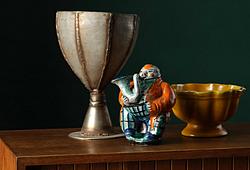John Bauer
"Prinsessan Tuvstarr" (Princess Tuvstarr)
Signed B. Executed in 1913. Indian ink, oval, 7.5 x 10 cm.
Alkuperä - Provenienssi
Originally in the collections of Paediatrician Ernst Bauer-Albrechtson (no. 2, acquired in 1926); by descent.
Näyttelyt
Kungl. Akademien för de fria konsterna (Royal Academy of Arts), Stockholm, "John Bauer. Minnesutställning", October 1934, no. 221.
Kirjallisuus
Konst i svenska hem, vol. 5, listed p. 262 (under collection 410: ”Barnläkare Ernst Bauer-Albrechtson, Sveavägen 112, Stockholm”); "John Bauers bästa. Ett urval sagor ur Bland tomtar och troll åren 1907-1915", 1931, illustrated full page on the cover; "BAUER. En konstnär och hans sagovärld", exhibition catalogue Nationalmuseum and Jönköpings läns museum, 1981, illustrated full page, p. 160.
Muut tiedot
Original vignette for the fairy tale 'Sagan om älgtjuren Skutt och lilla prinsessan Tuvstarr' published in "Bland Tomtar och Troll", 1913.
Taiteilija
John Bauer was born in 1882 and was a Swedish artist, primarily renowned for his paintings and illustrations in the early editions of the fairy tale collection "Bland tomtar och troll”. Thanks to his magical illustrations of princesses, trolls, and giants, Bauer has significantly influenced our perception of creatures and mythical figures in traditional Swedish stories and Nordic folklore.
Bauer grew up in Jönköping, and a large part of his artistry was inspired by the mystical forests of Småland, where trolls and other beings seemed to emerge from the rocky outcrops. During his years of study, he was fascinated by early German and Italian painting but soon returned to the Swedish fairytale forest. At the Royal Swedish Academy of Fine Arts, he met his future wife, Esther Ellqvist, who often posed as a model and served as inspiration for the princess Tuvstarr in Bauer's works.
Most of Bauer's paintings are created using watercolors, although he has also produced some using oil. By the 1910s, thanks to his fairy tale paintings, Bauer was already an established and beloved artist when he chose to conclude his role as a fairy tale illustrator. In his final years, he explored other imaginative expressions that would shape Bauer's last works, such as "The Dancing Nymphs" and "Blue Eva". John Bauer's final significant painting was created for the auditorium at Karlskrona Girls' School in 1917, an oil painting depicting the goddess Freja, with his wife Esther as a model.
The entire Bauer-Ellqvist family died in a boat accident when the steamer Per Brahe sank during an autumn storm on Vättern on November 20, 1918.




































